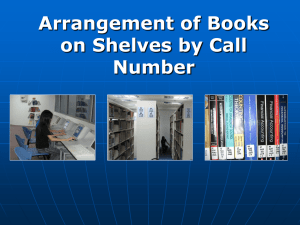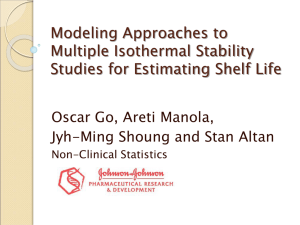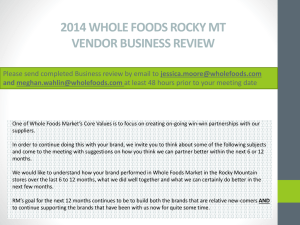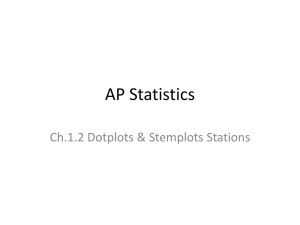Release Limit Calculations Current Practice
advertisement
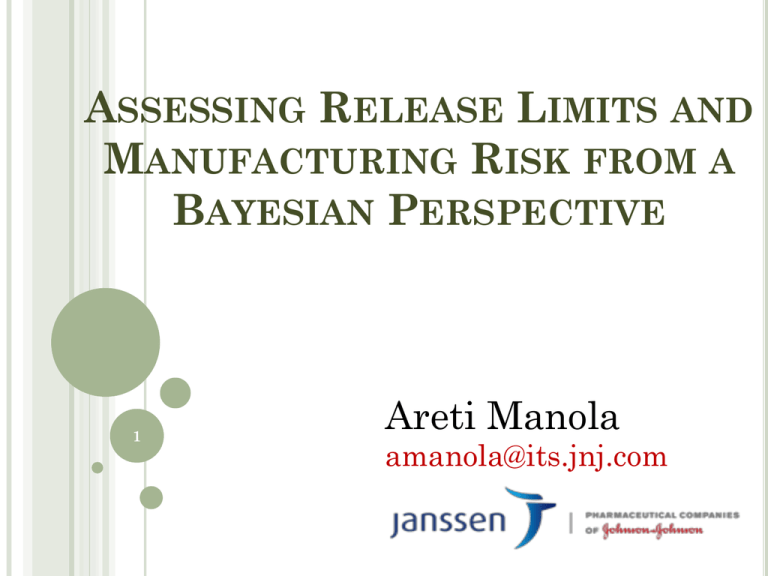
ASSESSING RELEASE LIMITS AND MANUFACTURING RISK FROM A BAYESIAN PERSPECTIVE 1 Areti Manola amanola@its.jnj.com OUTLINE Introduction Review Q1E Stability Evaluation Definition of Release Limits Allen, Dukes and Gerger Approach Mixed Linear Model A Bayesian Approach to Manufacturing Risk Estimation Bayesian formulation of mixed model Simulating future lots Posterior predictive distribution Case Studies Summary 2 ICH Q1E (2003) – STABILITY EVALUATION Summary Points A confidence level of 95% (one/two-sided at mean) is recommended for shelf life calculation. Shelf lives for individual batches should first be estimated using individual intercepts, individual slopes and the pooled mean square error calculated from all batches. Use shortest individual estimate for set(s) of batches Statistical test for batch poolability can be performed using a level of significance of 0.25. Comments No definition or recommendations for release limits calculations Current technologies allow mixed models and Bayesian approaches 3 DEFINITION OF RELEASE LIMITS Specifications ensure that the identity, strength, quality, and purity of a drug product are maintained throughout its shelf life. Release limits are the bounds of intervals on the true lot mean formed on the basis of given specifications and real time stability data so that a future lot whose measured value at time of manufacture falls within these limits has a high level of assurance that its mean will remain within specifications throughout shelf life. 4 RELEASE LIMITS Internally derived and are the responsibility of the manufacturer, lot acceptance limits Apply only at time of lot release Account for changes over time and uncertainties due to process variability Intended to provide a high level of assurance that a lot falling within release limits will conform to quality requirements over the shelf life of the product Important to the customer Given Release Limits and Specifications how can we assess manufacturing risk? 5 ALLEN, DUKES, & GERGER (ADG) - DETERMINATION OF RELEASE LIMITS: A GENERAL METHODOLOGY (1991) linear model: yi A B Ti i LRL LSL B TSL t1a ,k LRL LSL B TSL ST S t1-a,k n 2 S ST2 for B 0 n = lower release limit = lower specification limit = average slope for degradation = shelf life = standard error of average slope shelf life = assay standard deviation = one-sided (1-a)%-ile critical t value with k degrees of freedom = number of replicate assays used for lot release 105% Percent of Label Consider a fixed batch-specific A recent poll of 8 companies found that the ADG approach was used for either primary or secondary calculations of release limits by all 8 100% 95% Release Release Assay + Regression Loss Uncertainty Regression Loss 90% 85% 0 6 12 18 Time (Months) 24 6 OTHER APPROACHES Shao and Chow (1991) Constructing Release Targets for Drug Products: a Bayesian Decision Theory Approach Various choices of release limits are viewed as part of an action space; an action is chosen so as to minimize the cost through an appropriately chosen loss function Greg C. G. Wei (1998) Simple Methods for Determination of the Release Limits for Drug Products “Conditional “ release limits (control the chance of failure for a given lot - similar to Allen’s method) and “Unconditional” release limits (control the chance of failure for all future lots); expected loss function approach that minimizes cost due to lot failures at T0 & TSL Murphy and Hofer (2002) Establishing Shelf life, Expiry Limits and Release Limits Conditions shelf life on control limits at time of release 7 MIXED LINEAR MODEL RANDOM INTERCEPT yijk A ai B j Tijk ijk yijk = measurement of i-th batch at j-th condition and k-th time point, A = overall mean corresponding to process average at time 0, αi = random i-th batch effect on intercept: αi ~ N(0 , α2), Bj = fixed rate of change at j-th condition, Tijk = k-th sampling time for batch i at j-th condition, ijk = residual error: ijk ~ N(0, ε2). Possible to decompose the residual error further into other variance components if the design of the study permits, e.g. common analytical runs for specific groups of lots 8 Note: Extend Allen’s approach to mixed modeling framework by including additional variance terms MANUFACTURING RISK ESTIMATION Given Release Limits and Specifications, manufacturing risk can be described through a 2x2 table given below: End of Shelf Life Release Pass (%) Fail (%) Total (%) Pass (%) C11 C12 R1 Fail (%) C21 C22 R2 Total (%) C1 C2 100 C12/R1= P(YSL<SpecSL|Y0≥RL) cost to the company Probabilities associated with the above 2x2 table can be estimated through a Bayesian posterior predictive distribution approach 9 A BAYESIAN FORMULATION OF THE MIXED MODEL Without loss of generality, consider the mixed model: y Xβ Zf ε y = vector of observations with mean E[y] = X = vector of fixed effects: βtr = [A , B] f = vector of random effects: f tr = [α , ] with zero means a2 0 and variance-covariance matrix Varf 2 0 = vector of iid random error terms with mean zero and Var(ε ) = 2I X , Z = matrices of regressors relating the observed y to β and f Let θ be the vector of all parameters: θtr = [A , B , α , , a2 , 2 , 2 ] 10 A BAYESIAN FORMULATION OF THE MIXED MODEL The likelihood : y | θ ~ N (Xβ Zf , 2 I) The prior distributions: p(A), p(B) ~ Uniform Jeffreys’ prior: 2 p( a ) 1 , p( 2 ) a2 The joint posterior distribution: p(θ | y) p(θ) p( y | θ ) 1 2 , p( 2 ) prior 1 2 likelihood p( A, B, a , , a2 , 2 , 2 | y) p( A) p( B) p(a | a2 ) p( | 2 ) p( a2 ) p( 2 ) p( 2 ) p( y | θ) 1 1 1 N (a | 0, a2 ) N ( | 0, 2 ) N ( y | Xβ Zf , 2 I) a2 2 2 3 3 2 2 2 2 ( a ) ( ) exp 2 1 2 1 2 y A BT a ( ) exp 2 2 2 i 2 i 1 2 a 2 a 2 N 11 SIMULATION OF FUTURE LOTS (RANDOM INTERCEPT) Generate a posterior sample representing a set of process parameters from the posterior distribution of the parameters from the mixed model. This represents a random process, indexed by i, with parameters: Ai, Bi,ai2, i2 For each posterior sample i, generate a mean value for a kth random lot at time T (µk(i)T) by adding a lot effect (ak(i)) to the estimated process mean value at T as follows: mk(i)T =Ai +Bi *T +ak(i) , where ak(i) ~ N(0, ai2). Repeat this n times (k=1,2,…,n). For each random lot with mean µk(i)T at time T, add measurement error as: mk(i)T = µk(i)T + k(i)T, where k(i)T ~ N(0, i2). Repeat above steps for N random processes. Time of interest: T=0 (at release) and T=Shelf Life (e.g. 24 mos.). Note: Independence Chain Metropolis-Hastings algorithm used in SAS Proc Mixed procedure 12 MANUFACTURING RISK ESTIMATION Using the simulated lot data at T0 and TSL, calculate the probabilities of future lots falling into each of the 4 possible outcomes in relation to pass and fail at Release and end of shelf life . P(YSL<SpecSL|Y0≥RL) P(YSL>SpecSL|Y0 ≥ RL) P(YSL<SpecSL|Y0<RL) Yj = Lot mean at j-th time point, SL=shelf life 13 P(YSL>SpecSL|Y0<RL) OC CURVES CORRESPONDING TO THE 2X2 TABLE 14 CASE STUDIES 15 EXAMPLES 1 – ASSAY FOR IMPURITY B Stability data (up to 18 mos.) for the assay of Impurity B; 9 lots stored at 25C/60%RH temperature condition; 24 months shelf life Specification: ≤ 2.3 o 16 EXAMPLE 1: MIXED EFFECTS MODEL yij A ai B Tij ij yij = assay for ith lot at jth stability time point A = overall process mean at time of manufacture ai = random effect of the ith lot: ~ N(0, a2) B = rate of change per month Tij = jth stability time point for ith lot ij = Residual Variability ~ N(0, 2) a ’s, and ’s are mutually independent 17 17 EXAMPLE 1 – MIXED EFFECTS MODEL RESULTS Example 1 – Maximum Likelihood Compared to Posterior Estimates Fixed Effect A MLE (se) 1.56 (0.02) B 0.18 (0.01) 0.18 (0.15 – 0.20) MLE Posterior Median (95% interval) 0.0017 0.0019 (0.0006 – 0.0071) 0.0016 0.0016 (0.0010 – 0.0025) Variance Terms a2 (lot) 2 (resid) Posterior Mean (95% interval) Overall Mean at T0 1.56 (1.52-1.60) Monthly Rate Lot Variability Residual 18 EXAMPLE 1 – ADG RELEASE LIMITS CALCULATION RLU 2.3 b T z0.95 Var(b T ) Var(Re sid ) 1.87 Example 1 - % of simulated lots in categories of pass/fail for a specification=2.3 at 24 mos. and RL =1.87 (ADG method) End of Shelf Life Release Pass Fail Total Pass 99.99% 0 99.99% Fail 0.01% 0 0.01% 19 EXAMPLE 2: DISSOLUTION OF IR TABLET Stability data (up to 18 mos.) for 30 minutes dissolution; 7 lots stored at 25C/60%RH temperature condition Q-specification = 80% at 30 minutes; 24 months shelf life o 20 EXAMPLE 2: MIXED EFFECTS MODEL yk (ij) A ai B Tij ij k (ij) yk(ij) = dissolution of kth vessel for ith lot at jth stability time point A = overall process mean at time of manufacture ai = random effect of the ith lot: ~ N(0, a2) B = rate of change per month Tij = jth stability time point for ith lot ij = error II (Run-to-Run and unknown source of variability): ~ N (0, 2 ) k(ij) = error I (Vessel-to-Vessel variability): ~ N(0, 2) a ’s, ’s and ’s are mutually independent 21 21 EXAMPLE 2: MIXED EFFECTS MODEL RESULTS Example 2 – Maximum Likelihood Compared to Posterior Estimates Fixed Effect A MLE (se) 87.1 (1.0) B -1.0 (1.3) -1.1 (-3.7 – 1.3) MLE Posterior Median (95% interval) 0.8 1.9 (0.1 – 12.3) 10.9 10.5 (5.7 – 18.6) 12.6 12.7(10.5 – 15.6) Variance Terms a2 (lot) 2 (run) 2 (resid) Overall Mean at T0 Posterior Mean (95% interval) 87.1 (84.8-89.4) Lot Variability Monthly Rate Run Variability Residual 22 EXAMPLE 2 - ADG RELEASE LIMITS CALCULATION RL 80 b T z0.95 Var(b T ) Var( Run) Var(Vessel ) / 6 89.29 Example 2 - % of simulated lots in categories of pass/fail for a Q= 80% at 24 mos. and RL criterion= 89.29(ADG method) End of Shelf Life Release Pass Pass Fail Total 30% (97%)* 1% (3%)* 31% Fail 65% 4% 69% * probabilities conditional to row total (how many passed or failed shelf life specification from23those that passed the RL criterion) EXAMPLE 3: DISSOLUTION TRANSDERMAL SYSTEM o Stability data (up to 24 mos.) for the 30 minutes dissolution, 8 lots stored at 25C/60%RH temperature condition; additional Release data from 25 lots; 24 months shelf life. Specification (% label claim) Release 13 - 19 TSL (24 months) 9 - 16 o 3 Level Criterion for Testing Transdermal Delivery Systems – USP <724> 24 EXAMPLE 3: MIXED EFFECTS MODEL RESULTS Mixed effects modeling with fixed intercept and slope and random intercept, run and vessel effects (similar to Example 2) Example 3 – Maximum Likelihood Compared to Posterior Estimates Fixed Effect MLE (se) Posterior Mean (95% interval) A 15.5 (0.1) 15.5 (15.2-15.9) B -2.4 (0.1) -2.4 (-2.7 – 2.2) MLE Posterior Median (95% interval) Variance Terms a2 (lot) 0.47 0.48 (0.24 – 0.95) 2 (run) 0.22 0.22 (0.12 – 0.39) 2 (resid) 0.42 0.42 (0.37 – 0.48) 25 EXAMPLE 3 - ADG RELEASE LIMITS CALCULATION RLL 9 b T z0.95 Var(b T ) Var( Run) Var(Vessel ) / 6 14.8 Example 3 - % of simulated lots in categories of pass/fail for a Q= 9 - 16% at 24 mos. and RL criterion= 14.8 - 19 (ADG method) End of Shelf Life 9 - 16 Release 14.8- 19 Pass Fail Total 0.2% 79.4% 79.6% (0.2%) Pass (99.8%) Fail 18.9% 1.5% 20.4% * probabilities conditional to row total 26 SUMMARY ADG method does not address risk in a statistically derived probability sense, more a heuristic calculation than statistical. Applies to individual lots as manufactured More decision rule rather than risk control strategy ADG approach can be extended to the mixed effects model. Allows for more flexible description of a manufacturing process and relevant variance components Sets the stage for a hierarchical Bayesian approach Current technology allows the application of a Bayesian approach in a fairly direct and uncomplicated way. 27 SUMMARY Bayesian posterior predictive approach addresses manufacturing risk by allocating measured outcomes into categories of acceptable and unacceptable lots at both release and end of shelf life given specifications and release limits Predictive posterior distribution of future lots can be easily generated a natural interpretation of manufacturing risk as a probability. The risks associated with the manufacturing process are expressed via 2x2 tables displaying joint release and end of shelf life outcomes as probabilities. Release limits as a control strategy can be assessed by calculating the OC curve corresponding to the 2x2 table outcomes generated across a range of release point values or intervals. Costs to the company associated with the risks can be calculated. Provides elements of a comprehensive risk control strategy missing in the ADG method 28 Expert opinions, historical data from diverse sources and prior knowledge may be integrated into a prior distribution. REFERENCES Allen, Dukes, & Gerger (1991). Determination of Release Limits: A General Methodology . Pharmaceutical Research, Vol. 8, No. 9, pp.1210-1213. Shao and Chow (1991). Constructing Release Targets for Drug Products: a Bayesian Decision Theory Approach. JRSS, Series C (Applied Statistics) 1991, 40, No. 3, pp. 381-390. Greg C. G. Wei (1998). Simple Methods for Determination of the Release Limits for Drug Products. Journal of Biopharmaceutical Statistics, 1998, 8(1), 103-114. Murphy and Hofer (2002). Establishing Shelf life, Expiry Limits and Release Limits. Drug Information Journal, 2002, vol. 36, pp. 769-781. Andrew Gelman, John B. Carlin, Hal S. Stern and Donald B. Rubin (2004). Bayesian Data Analysis. 2nd ed. Chapman & Hall/CRC. 29

